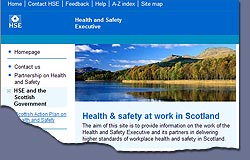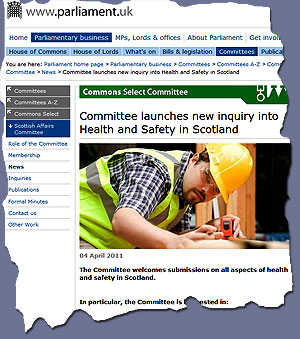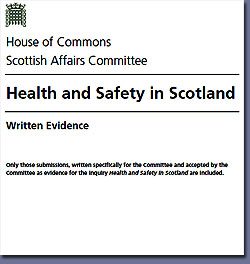What Next For Health And Safety In Scotland?
Around 20 per cent of the UK’s biggest killers, including heart disease, cancer and chronic respiratory disease, are caused by work, suggesting annual work-related disease deaths exceed 50,000 with working wounded totalling several million according to the campaigning organisation Hazards.
Whilst the Health and Safety Executive (HSE) is the body responsible for enforcing and advising on UK law – health and safety being a matter reserved to Parliament. It seriously under-estimates workplace injuries and diseases but notes 147 UK workers were killed at work in the year up to June 2011.
 Whilst most of the discussions so far on the issue of cuts to the HSE have covered the whole of the UK, in Scotland concern is no less vocal within both the political and health & safety communities.
Whilst most of the discussions so far on the issue of cuts to the HSE have covered the whole of the UK, in Scotland concern is no less vocal within both the political and health & safety communities.
A leading publication within the left of the political spectrum, Scottish Left Review, has recently entered the debate over the cuts in HSE budgets and the continued lurch toward an American style hands-off approach to industry regarding health & safety, now being finalised by the Tory-led coalition government.
In 2011 a swathe of official inquiries looked at the subject. These have included Parliament’s Scottish Affairs Committee, the Scottish Parliament’s Scotland Bill Committee and a Department of Work and Pensions inquiry.
In an article entitled ‘Work is killing us’ authors Andrew Watterson, Tommy Gorman, and Jim McCourt take a close look at the history of Health & Safety culture and legislation in the UK with specific concerns for the effects in Scotland.
Here, we cover some of the main issues discussed in the full article:
Giving a brief outline of the background to health & safety legislation, they write:
‘UK occupational health and safety history is based on great struggles usually by trade unions, often because of pressure from their lay members, and aided by enlightened politicians to get through any ‘state’ protection. This was so on child labour in the 18th Century through factory, office and railway acts to the 1974 Health and Safety at Work etc Act. The 1974 Act still relied on weak tripartism, however, and emerged from Lord Robens’ advocacy of self-regulation. Robens’ Vickers and NCB history seeped through his proposals. It took trade union pressure to obtain the 1977 regulations on safety representatives that gave the Act real bite. The 1970s were halcyon days for health and safety, with an active staff and an energetic group of occupational health specialists, when compared with the decades that followed.’
They go on to outline the fact that it is from the EU, that the UK laws on H&S were stiffened up:
‘The EU in the 1980s also resolved conflicts between its aims of freeing markets and protecting citizens in positive ways by bringing in workplace health and safety directives that went way beyond what Thatcher’s governments would have countenanced. Yet the 1980s saw the emergence of the neo-liberal counter-offensive in Europe led by Dutch and British MEPs who argued for major cuts in health and safety regulation.’
Setting historical record straight they crush the myth that it is only the Tory governments that have attacked H&S legislation, they state:
‘The offensive against health and safety at work has gathered momentum and explains both Blair and Brown’s espousal of deregulation and related strategies running the gamut of what has euphemistically been called better regulation, softer regulation and smarter regulation. Blair and co constantly cut the budgets of bodies like HSE.
David Cameron’s administration has simply continued those policies now bringing in a huge 35 per cent cut in HSE’s budget between 2010 and 2014. It appears that reactive inspections will now dominate HSE strategy, with planned cuts of a third in future pro-active inspections. A whole range of industries and employment settings look likely to be re-categorised as low risk too.’
 With regard to the HSE, they make the following observation:
With regard to the HSE, they make the following observation:
‘HSE is a strangely masochistic body and fails to champion workplace health and safety. Successive government tell it that cuts will come: HSE acquiesces quietly and leaves itself open to more and more cuts. However, it is politicians, governments and some employer bodies, driven by ideology and lacking in sound evidence, that explain the real crisis in workplace health and safety not HSE pusillanimity. HSE for example did show in the 1980s and 1990s that ‘good health and safety’ was good business and that each year the UK lost the equivalent of a year’s economic growth through injuries and illnesses at work.’
Turning to the current situation, the article continues:
‘Much is made of the UK’s health and safety record but the UK came 20th out of 30 OECD countries listed.............
Despite recent research from the USA that shows regulations work and that voluntary and self-regulated health and safety schemes do not, the UK government carries on its ideological way.
Chris Grayling, the UK employment minister, still refuses to meet the body that speaks for the many workers killed at work, Families Against Corporate Killing (FACK), yet in the last four months has met 10 industry bodies, several of whom advocate the cutting red tape agenda with precious little if any evidence to support their case.
FACK in contrast is a national campaigning network to stop workers and others being killed in preventable incidents and supporting bereaved families through sources of legal and emotional help. For example, they represented relatives of Graham Meldrum who was killed at work on 12 July 2005. He was working as an agency driver for TNT delivering to Allied Bakeries in Glasgow and paltry fines of £33,500 resulted for those companies: a worker’s life still comes very cheap in Scotland.’
Turning to the issues in relation to Scotland, the report continues:
‘The position in Scotland, controlled by Westminster, is not only no better than England and Wales but in several respects it is worse. We have in the past seen major disasters, such as Piper Alpha in 1988 which killed 168 people and ICL/Stockline in 2004 which killed nine workers and injured dozens more. Serious failings in Scottish HSE governance emerged after the 2004 explosion linked to failures to protect non-union employees by ineffectual enforcement of regulations (www.theiclinquiry.org). Now we have an enormous epidemic of occupational disease due to asbestos and other substances in some of the most vulnerable, deprived and de-industrialised parts of the country.
HSE figures not only under-estimate injuries and diseases, they also take no proper account of a hostile economic environment where employees are fearful for their jobs, bad employers have greater and greater freedom from government agencies to not report injuries and diseases, changes in reporting systems like RIDDOR will lead to a further reduction of reported injuries and diseases, and many employees have to adopt presenteeism (going to work when ill) because of fears for job security.
 The HSE itself admits Scotland has a higher fatality and major injury rate than the rest of the UK but simply explains this away on the basis of more hazardous industries existing here. That appears to be astonishingly complacent and seems to indicate the rates are inevitable. In countries like Australia, highly hazardous industries such as mining have seen such rates decline when there has been an expansion of the industry. HSE Scotland all too often emerged as an apologist for failures to protect workers effectively. This is unlike the current situation in the USA where OSHA leaders reflect a commitment to raising health and safety standards. HSE recommended 43 cases for prosecution in Scotland in 2009-10, compared to 75 in 2007-08 and 84 in 2008-09.3 (NAO 2011:8).
The HSE itself admits Scotland has a higher fatality and major injury rate than the rest of the UK but simply explains this away on the basis of more hazardous industries existing here. That appears to be astonishingly complacent and seems to indicate the rates are inevitable. In countries like Australia, highly hazardous industries such as mining have seen such rates decline when there has been an expansion of the industry. HSE Scotland all too often emerged as an apologist for failures to protect workers effectively. This is unlike the current situation in the USA where OSHA leaders reflect a commitment to raising health and safety standards. HSE recommended 43 cases for prosecution in Scotland in 2009-10, compared to 75 in 2007-08 and 84 in 2008-09.3 (NAO 2011:8).
There are clearly serious questions to be raised about to what extent the UK health and safety regulatory system protects and addresses the needs of Scottish workers. For the reasons outlined above, it appears to have failed and perhaps should be more directly accountable to the Scottish government for its work.
Health and safety at work has historically only been protected by pressure on employers and government from employees, from trade unions and from civil society. Trade union activity through safety representatives provides the best protection but trade unions have been weakened and many employees are not in unions.
What is therefore now needed in Scotland is a multi-layered approach. The Scottish government has a unique opportunity to demonstrate, as it has done on the NHS and social care, a different and more humane approach on workplace health and safety and support for those damaged by work than occurs in England.
What Scotland needs is:
Action to prevent further HSE cuts
- Greater accountability of HSE to Scottish civil society in terms of actions, resourcing and staff perhaps through a dedicated Scottish Occupational Health and Safety Agency
- The effective linkage of occupational health to public health with greater activity on prevention and in primary care. Data on injuries and diseases should be collated from the acute and primary care sectors and GPs should work with trade unions and community groups to identify problems along the lines of SOHAS in Sheffield
- The establishment of a Scottish worker health and safety centre to advise employees, unionised or not, about prevention and detection of disease and injury and support for victims. This could be created by re-aligning funds from health promotion initiatives that should be spent on preventing workplace hazards.
- Linking good health and safety records with economic and other benefits from the Scottish ministries responsible for health, business and the environment and promotion of initiatives such as toxics use reduction so successfully pioneered in the USA
Further information on debates about occupational health and safety hazards and policies can be found in Hazards magazine www.hazards.org the Institute of Employment Rights and FACK
You can read the full unedited article here
Download the written evidence document from the E-Library using search term 'Scotland'
Source: Scottish Left Review / House of Commons




